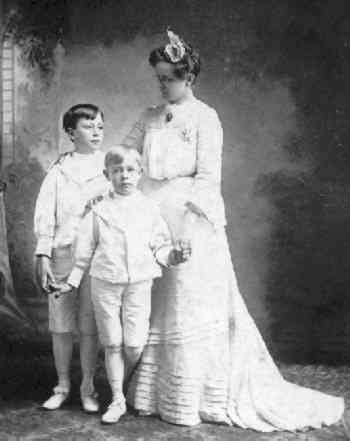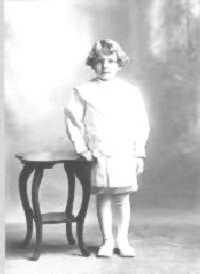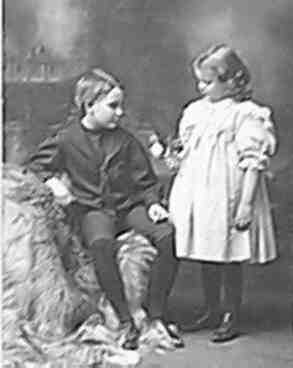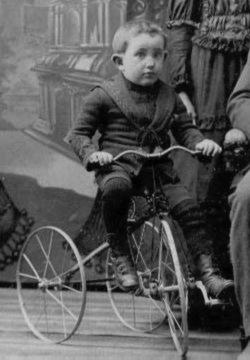
Solid Colored Sailor Suits

Figure 1.--The adoring mother of these two brothers has chosen all
white kneepants sailors suits. They are worn with long white stockings
and white strap shoes with bows. I believe the photograph is American
and taken in the early 1900s. Notice that mother wears a coordinated all-white dress.
|
One elegant style of sailor suit appeared in the late 1890s. It was
a solid color suit without any stripes are embelishments. These suits
appeared in both navy blue and white. Some of the navy blue
suits might have
white dickeys or other appointments, but with this exception they were
for the most part entirely devoid of embelishment. While sailor suits
were often casual evrey day wear, these solid colors suits were generally
considered more formal outfits. These suits were most popular during the
1900s and early 1910s. Often these suits were worn with
matching appointments such as stockings or kneesocks and shoes. Regular
low cut shoes were most common. For dress occasions strap patent leather
shoes were often worn.
White Suits
Middy blouse
Middy blouses were usually pull-over garments. Some of the middy
blouses for white suits, especially the more formal ones, were front
buttoning.
Younger boys might wear more of a tunic outfit with sailor styling
rather than a middy blouse. These tunics were worn with belts as a
stylic detail. The tunics were worn with knickers rather than kneepants.
The tunic was worn at a length which wouls show the hem of the knickers.
Pants
Solid white sailor suits without the traditional blue stripes
almost always were worn with kneepants. Many times the all-white
theeme meant even the buttons on the boys' kneepants were white.
Accessories
Most sailor suits were worn with a silk keckerchief tied in a bow
as sailors used to wear. The images I have seen so many of the boys
with all white suits without the bows.
Shoes and stockings
Boys in all white sailor suits usually dressed formally with
long white stockings. Often but not always the boys wore matching white
strap shoes--some adorned with white bows.
Hats
I am not sure what type of head gear was worn with the white suits.
The most likely was matching white sailor caps. After the tuen of the
century, wide-brimmed
sailor caps became less commonly worn, especially by older boys.

Figure 2.--This boy wears an all-white sailor tunic with his natural
over-the ears curls. The image was probably taken in the 1900s.
|
Hair styles
Many of the boys in white sailor suits wear short hair. Some boys
seem to have longer over the ears hair with natural curls. Less common
are ringlet curls.
Ages
These white sailor suits were worn by boys of different ages. The
younger boys commonly wore dresses, kilts or Fauntleroy suits. Boys ]
who wore white sailior suits were usually boys from about 5 years of
age to 10 or 11 years, but some older boys of 12 or 13 also wore them.
Conventions
I believe the all white sailor suit was considered to be a rather
elegant, formal attire. Some boys wore light-colored or stripped
sailor suits during the summer, often with dark stockings. This was
considered a more casual outfit. White sailor suits bwith white stockings and
even white shoes was considered very formal. Obviously you wouldn't
send your boy outside to play in such an outfit.
Material
Country patterns
I have not yet assessed the different patterns in various countries.

Figure 3.--Blue suits could also be for formal wear, but less commonly than white suits. Some solid colored blue suits were for play. Much depended on the material the suit. His sister wears a protective pinafore. The family was the Staltonstalls and the photograph was taken in 1898.
|
Blue Suits
Blue suits could also be for formal wear, but less commonly
than white suits. Some solid colored blue suits were for play. Much
depended on the material the suit.
Color
The available images or black and white photographs. I believe, however,
that the dark-colored suits were usually navy blue. I'm not sure if there
were any black suits.
Middy blouse
Most blue sailor suits were pullover middy blouses. Some of the dark
suits without detailing beyond perhaps an embroidered nautical symbol on
the dicky could be worn formally. Other suits had embroidery on the
sailor collar or even the sleeves.
Boys from affluent families might have a blur sailor suit which they
used fir every day wear. They might have a FFauntleroy or other fancy
suit for their paty outfit. Other solid-colored suits were made of less
expensive material for play wear. Boys from less affluent families might
have a blue sailor suit as their dressup outfit.

Figure 4.--This family was photographed about 1890. The boy appears
to have a blue sailor kneepants suit as his best outfit--with long
ribbed stockings. The suit has emroidery on
the sailor collar. Click on the image for a view of his family.
|
Pants
Formal blue suits were mostly worn with kneepants, in part because
wearing sailor suits for formal occasions was most common when kneepants were
in style. Formal sailor suits were also worn with long pants, but this was
more common for suits with authentic detailing. Solid colored blue play suits were most commonly worn with
knickers or short pants.
Accessories
Solid blue suits were almost always worn with a black silk scarf.
Shoes and stockings
Hats
Christopher Wagner
histclo@lycosmail.com
Navigate the Boys' Historical Clothing Web Site:
[Introduction]
[Chronology]
[Clothing styles]
[Biographies]
[Bibliographies]
[Activities]
[Countries]
[Contributions]
[Boys' Clothing Home]
Navigate the Historic Boys' Clothing Web sailor pages:
[Return to the Main sailor page]
[Middy blouse]
[Reefer jackets]
[Sailor dresses]
[Other sailor styles]
[Sailor hats]
[Middy suits]
[National sailor suits]
[The Royals]
[Ring bearer/page costumes]
Created: January 15, 1999
Last updated: August 15, 1999





